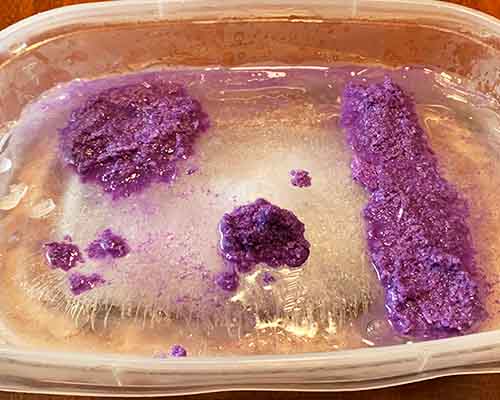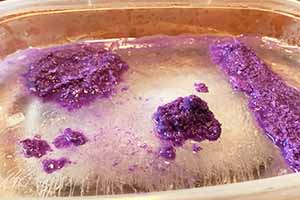Ice Sculpting

Ice Activities for Preschoolers
Young children will love these ice sculpting activities that can be done indoors.
If you're looking for ice activities for preschoolers, consider this one.
By Hollie Barattolo
Ice Activities for Preschoolers
Young children will love these ice sculpting activities that can be done indoors. If you're looking for ice activities for preschoolers, consider this one.
By Hollie Barattolo
Ages/Grades
Preschool, Early Elementary
Learning Domains
Science, Fine Motor
Materials
- • Snow or Ice
- • If you are doing the experiment indoors, you can freeze water in a bin or tray
- • Ice Cubes (1 per student for observations)
- • Tempera Paint (½ cup per student)
- • Kosher salt
- • Feel free to experiment with other salts!
- • Marble (optional)
Ready, Set, Go!
 If you do not have snow or ice outside, freeze water in a tray or bin for exploration.
If you do not have snow or ice outside, freeze water in a tray or bin for exploration. Create your salt paste: add salt to a half a cup of paint for each student. Add enough salt so that the paint takes on a gritty, thick paste/dough-like consistency.
Create your salt paste: add salt to a half a cup of paint for each student. Add enough salt so that the paint takes on a gritty, thick paste/dough-like consistency.- Tip: The ratio of salt to paint will change depending on how watery your paint is to start.
 Make observations about ice cubes.
Make observations about ice cubes.- Exploration Questions: How big is the ice cube at the beginning of the observation? How big is it at the end? If you shine a light on your ice cube, does it change? Do you notice any water around your ice cube? When you touch your ice cube, how does it feel?
 Lead a conversation about ice. Take suggestions from your students on ways to melt ice. Can they think of other ways to melt ice?
Lead a conversation about ice. Take suggestions from your students on ways to melt ice. Can they think of other ways to melt ice?- Tip: Include some silly ways like dragon’s breath!
 Make observations about the salt paste. Make predictions about what will happen when you add the paste to the ice.
Make observations about the salt paste. Make predictions about what will happen when you add the paste to the ice. Place a small amount of the paste on the surface of the ice and watch what happens. Check back in 5 minutes, 10 minutes, 15 minutes, 20 minutes.
Place a small amount of the paste on the surface of the ice and watch what happens. Check back in 5 minutes, 10 minutes, 15 minutes, 20 minutes.- Exploration Questions: Does the paste stay where you put it? Is there more water under the paste?

 Wipe off the ice. Rinse with cold water. Make observations about the ice after the paste is removed.
Wipe off the ice. Rinse with cold water. Make observations about the ice after the paste is removed.- Exploration Questions: Does the ice look any different? Run your fingers along the surface. Does it feel different? Can you tell where the paste was on the ice? What would happen if we left the paste on even longer?
- Extension: Use the paste to make a path along the surface of the ice. Let it sit on the surface of the ice for about 15 minutes. Scrape it off, taking the slushy ice in the path with it. Add a marble and you have a homemade marble run.
 What’s happening?
What’s happening?- Salt doesn’t melt ice, but salt added to water lowers its freezing point by making it harder for the water molecules to make the rigid formations they need for ice to form. Ice and snow almost always have a thin layer of water at the surface. As salt dissolves in the water, that water will no longer freeze at the same temperature as the water around it. This salty water (with a lower freezing point) melts the ice below it.
 Hollie is certified K-8 teacher who has been educating in the informal education field since 2005. She has developed and implemented countless exciting STEAM programs for families, classrooms, and teachers focused on the natural world, the scientific process, and ancient life. Her professional passions are inquiry, whole family learning, experiential learning starting in early childhood, and the intersection of literacy and science instruction.
Hollie is certified K-8 teacher who has been educating in the informal education field since 2005. She has developed and implemented countless exciting STEAM programs for families, classrooms, and teachers focused on the natural world, the scientific process, and ancient life. Her professional passions are inquiry, whole family learning, experiential learning starting in early childhood, and the intersection of literacy and science instruction.
She has recently developed a community-based program that encourages families to use dramatic play to learn science, increase literacy skills, and have fun together for which she received the Drexel University Presidential Award for Civic Engagement. She is most proud of her work on a popular science storytelling program for preschool families and classrooms that combines a book club format with engaging programs, innovative curriculum, and a hysterical puppet storyteller.
